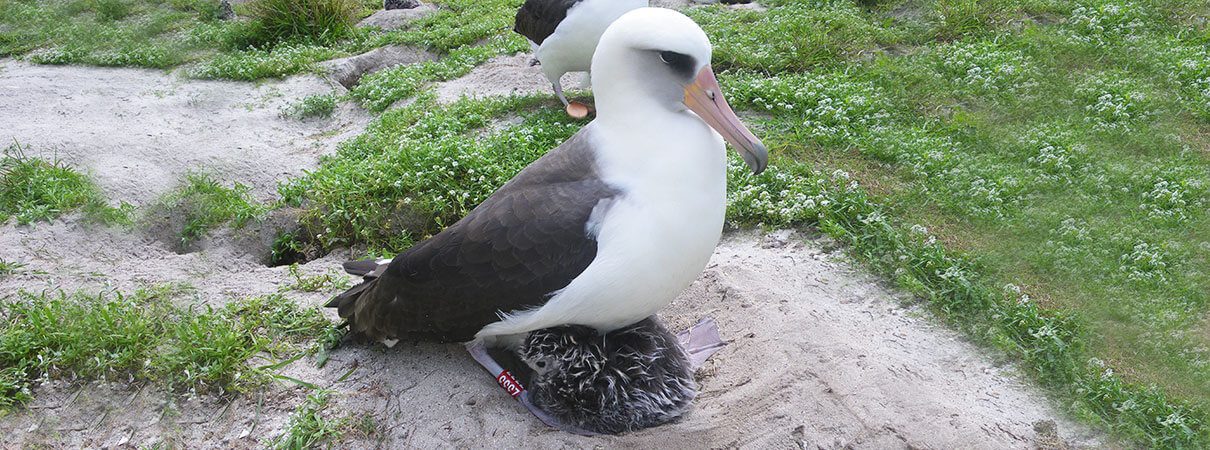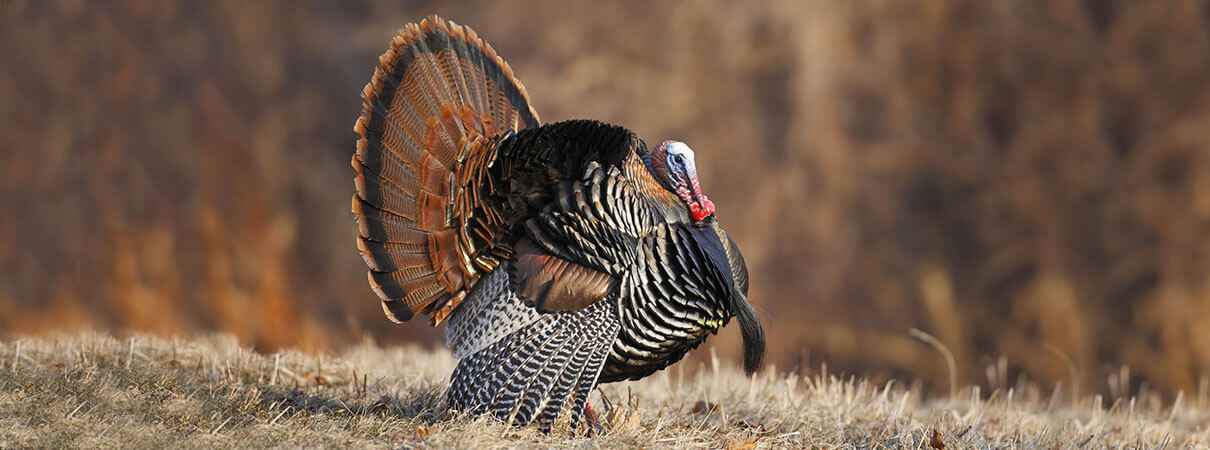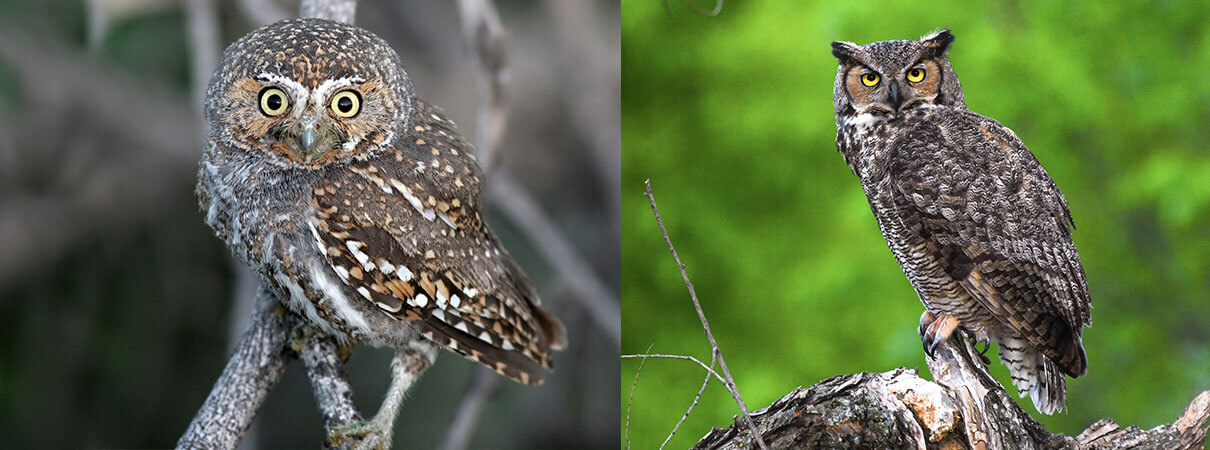The Surprisingly Complex Science of Bird Longevity
How long do birds live? Whether you want to ace this question at your next bird-themed trivia challenge or just impress someone spontaneously, here's the answer: Birds can live between four and 100 years, depending on the species.
While it may win you trivia points, this answer may raise more questions than it resolves: Why is there such a range of lifespans? Which birds live the longest? Can some birds really live to be 100?
Answering these questions proves to be surprisingly hard. In many cases, the seemingly simple question of how old is that bird can be impossible to answer.
By learning a few basic facts about how birds age, however, we can gain some interesting insights into bird lifespans and even begin to understand which of the familiar species around us are likely to be living longer (and shorter) lives.

Wisdom, a 69-year-old female Laysan Albatross, currently holds the record as the oldest-known wild bird. Photo by USFWS
Birds don't age like we do
As humans, we're accustomed to using visual hints to guess the age of someone or something. The neighbor's dog with flecks of gray fur and a stiff walk is obviously getting up in years. That huge gnarled tree in the park must have been there for decades.
Birds are different. They don't get gray; they don't become arthritic; they don't get bigger with each passing year; they don't leave growth rings for us to count.
In fact, once most birds develop their adult plumage, they essentially become impossible to age.
How birds are able to accomplish this remarkable feat is not yet fully understood, but it probably has to do with how their bodies process oxygen and the proteins associated with metabolism.
The reality that birds don't show physical signs of aging creates a challenge for understanding how long they live: If we can't age adult birds, how can we study their lifespans?

Cookie, a Pink Cockatoo, lived to the age of 83, making her the world's longest-living bird. Photo by Brookfield Zoo/Flickr
What we know (and don't know) about the oldest birds in the world
If you Google “longest-lived bird,” you will find multiple claims of birds that lived for over 100 years. Some birds may have even lived to be 120!
Take these claims with a grain of salt.
These records depend on knowing when a bird hatched, a fact we usually do not have if the bird was born in the wild. Also, as with fishing stories, bird fanciers sometimes exaggerate how long their birds live.
According to Guinness World Records, the oldest confirmed bird is “Cookie,” a Pink, or Major Mitchell's, Cockatoo that lived to the age of 83 at the Brookfield Zoo near Chicago.
Some birds have almost certainly lived to be older than 83 (hence the upper range of the trivia answer), but for now, we do not yet have definitive confirmation of an avian centenarian.
It is usually difficult to age wild birds
As the claims for the title of “world's oldest bird” demonstrate, accurately aging birds, even in captivity, is challenging. For wild birds, it is even harder. There's the obvious problem that wild birds are difficult to keep track of. In almost all cases, it is impossible to know when exactly an individual bird began or ended its life. Furthermore, animals in the wild lead very different lives from those in captivity and the insights gained from captive individuals may not always be relevant to those in the wild.
Our knowledge of birds' lifespans in the wild comes almost entirely from bird banding. The theory behind this technique is simple: If you catch a bird that has already been banded, you can confirm its age — or at least the time elapsed since it was originally caught.
In practice, though, aging birds from banding is more complicated than it seems. Only a small percentage of banded birds are ever observed again, and if they were adults when they were first banded, their starting age is unknown.

Red-tailed Hawks have been recorded living up to 30 years. Photo by Stanislav Duben/Shutterstock
Relatively speaking, birds live a long time
While there is still a lot to learn about how long birds live in the wild, one thing is clear: Many birds live much longer than we might expect.
Life expectancy in the animal world generally correlates with metabolic rate. In mammals, this is often linked to body size: Big mammals with slower metabolisms generally live longer lives; small ones with faster metabolisms live shorter lives. Humans, for example, live longer than dogs and cats, which live longer than mice and hamsters. (As is often the case with these generalized patterns, there are exceptions.)
Many birds are small and have extremely high metabolic rates. So, we would expect birds to be relatively short-lived. But they aren't.
On the contrary, many birds live an extraordinarily long time, particularly when compared to similar-sized mammals. For example, under ideal conditions in captivity, a House Mouse can live four years. Meanwhile, a Broad-billed Hummingbird (a quarter the size of the mouse) can live up to 14 years in the wild.
Barn Swallows have been recorded living 16 years, enough time for these prodigious travelers to have traveled roughly half the distance to the moon during their annual migrations. European Goldfinches can live up to 27 years. Common Ravens are known to have lived 69 years, more than twice as long as the oldest-known dog.
As with their lack of physical aging, we are also still learning how birds are able to live so long with their super-fast metabolisms. The answers may offer clues to understanding aging in our own species.
One important point to keep in mind: Just because birds can live a long time doesn't necessarily mean that all individuals of the species do live that long. Similar to us humans (who have been recorded living to 122), most individuals will have shorter lives than those at the extreme.

The oldest recorded Wild Turkey lived for 15 years. Photo by Paul Tessier/Shutterstock
Clues for identifying the longer (and shorter) lived birds around you
For those of us watching birds at our feeders or birding in the field, it will almost always be impossible to accurately age individual wild birds once they are adults. But we can begin to understand which of the bird species around us are likely to be longer (and shorter) lived.
Longer lifespan is often associated with features of a bird's biology and natural history. Here are five characteristics that can help us make an educated guess about which species are likely to be longer-lived:
- Body size. On average, larger species tend to live longer than smaller species.
- Number of chicks. Birds with longer lifespans often have fewer young, while those with shorter lifespans tend to have more.
- Years to reach adulthood. Shorter-lived species tend to reach adulthood more quickly than longer-lived species.
- Life on the ground. Birds that live and nest on the ground have often adapted for shorter lifespans than those that live higher up, such as in the shelter of the tree canopy.
- Island life. Birds that live and nest on islands are often longer-lived than their mainland counterparts.
Keeping these insights in mind, which do you think lives longer: A Wild Turkey or a Red-tailed Hawk?
To get started, here are a few basic facts: Turkeys are larger than Red-tails (up to 24 lbs. versus vs. 2.8 lbs.), have substantially more chicks (up to 17 eggs versus up to five eggs), reach adulthood more quickly (one year versus three years), and live on the ground.
If you chose the Red-tailed Hawk, you're right. Red-tails have been recorded living up to 30 years, while the oldest recorded Wild Turkey was 15 years old.
In addition to these biological and ecological features, there is another factor that often predicts how long a bird species is known to live: How much people have studied it. In general, birds that have been better studied are more likely to have records of long-lived individuals. Given how difficult it is to age birds, this makes sense. It also shows how much there still is to learn about how long many bird species can live.
Longevity records for some familiar North American birds in the wild (based on banding data from the Patuxent Wildlife Research Center Bird Banding Laboratory). To see more records, take a look at our expanded wild bird longevity graph.
| Species | Age |
| Mallard | 27 years |
| Elf Owl | 5 years |
| American Flamingo | 49 years |
| Laysan Albatross | 68 years |
| Great Blue Heron | 24 years |
| Bald Eagle | 38 years |
| Sandhill Crane | 37 years |
| Atlantic Puffin | 33 years |
| Great Horned Owl | 28 years |
See if you can use what you know about the size and natural history of some of these familiar birds to notice patterns in their lifespans. Remember, not all of these characteristics are hard-and-fast rules, and sometimes patterns are influenced by how much we have studied a species. For more, check out the avian longevity records by species from the Patuxent Wildlife Research Center Bird Banding Laboratory.

Smaller owls like the Elf Owl can live up to five years; larger species, like the Great Horned Owl, can live to be nearly 30. Photos (left to right) by Terry Sohl and Brent Barnes/Shutterstock
Longevity and Conservation
Longer-lived birds often have fewer young each breeding season and take longer to reach adulthood. This means that their ability to successfully produce young can be dependent on each individual being able to live a long time. Wisdom, a 69-year-old female Laysan Albatross that currently holds the record as the oldest-known wild bird, may have produced as many as 36 chicks over the course of her life. If this seems like a lot, consider that a very productive female turkey might produce nearly that many chicks over the course of one or two years!
The slow-paced lifestyle of long-lived birds such as albatrosses can have important consequences for conservation. On islands, for example, where birds have long lifespans, the introduction of new threats such as invasive predators can have disastrous results.
ABC's work to protect long-lived island-nesting birds such as the Hawaiian Petrel is one way we're helping long-lived bird species continue to make the most of their slow and steady lifestyles.
ABC works to improve prospects for birds throughout the Americas and beyond. This means taking on human-caused challenges to birds including habitat loss, building collisions, pesticides, and climate change. Your support helps us achieve conservation for birds and their habitats.
Dr. Steve Austad generously offered advice for this blog. His book Methuselah's Zoo, which focuses on aging in the animal world, comes out in 2021.
 | John C. Mittermeier is the Director of Threatened Species Outreach at ABC. He works with ABC's partners in Bolivia and helps to lead ABC's lost birds and bird trade initiatives. |


















































